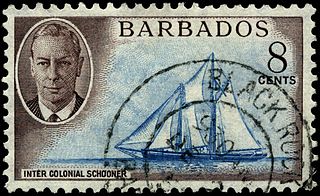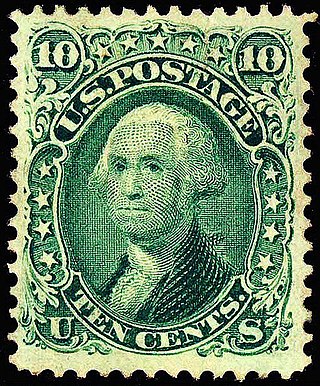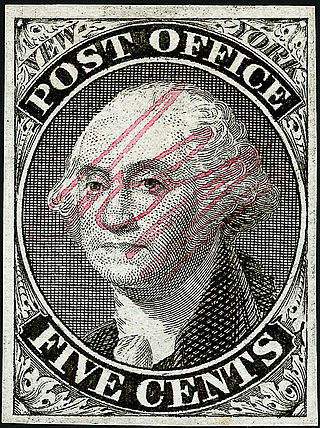Related Research Articles

A postage stamp is a small piece of paper issued by a post office, postal administration, or other authorized vendors to customers who pay postage. Then the stamp is affixed to the face or address-side of any item of mail—an envelope or other postal cover —which they wish to send. The item is then processed by the postal system, where a postmark or cancellation mark—in modern usage indicating date and point of origin of mailing—is applied to the stamp and its left and right sides to prevent its reuse. Next the item is delivered to its addressee.

Stamp collecting is the collecting of postage stamps and related objects. It is an area of philately, which is the study of stamps. It has been one of the world's most popular hobbies since the late nineteenth century with the rapid growth of the postal service, as a stream of new stamps was produced by countries that sought to advertise their distinctiveness through their stamps.

The Penny Black was the world's first adhesive postage stamp used in a public postal system. It was first issued in the United Kingdom on 1 May 1840 but was not valid for use until 6 May. The stamp features a profile of Queen Victoria.

The postal and philatelic history of Canada concerns postage of the territories which have formed Canada. Before Canadian confederation, the colonies of British Columbia and Vancouver Island, Prince Edward Island, Nova Scotia, New Brunswick and Newfoundland issued stamps in their own names. The postal history falls into four major periods: French control (1604–1763), British control (1763–1841), colonial government control (1841–1867), and Canada, since 1867.

The Uniform Penny Post was a component of the comprehensive reform of the Royal Mail, the UK's official postal service, that took place in the 19th century. The reforms were a government initiative to eradicate the abuse and corruption of the existing service. Under the reforms, the postal service became a government monopoly, but it also became more accessible to the British population at large through setting a charge of one penny for carriage and delivery between any two places in the United Kingdom of Great Britain and Ireland irrespective of distance.

Postal service in the United States began with the delivery of stampless letters whose cost was borne by the receiving person, later encompassed pre-paid letters carried by private mail carriers and provisional post offices, and culminated in a system of universal prepayment that required all letters to bear nationally issued adhesive postage stamps.
This is a partial timeline of significant events in postal history, including dates and events relating to postage stamps.

Postage stamps and postal history of Great Britain surveys postal history from the United Kingdom and the postage stamps issued by that country and its various historical territories until the present day.
The Penny Post is any one of several postal systems in which normal letters could be sent for one penny. Five such schemes existed in the United Kingdom while the United States initiated at least three such simple fixed rate postal arrangements.

The Mauritius "Post Office" stamps were issued by the British Colony Mauritius in September 1847, in two denominations: an orange-red one penny (1d) and a deep blue two pence (2d). Their name comes from the wording on the stamps reading "Post Office", which was soon changed in the next issue to "Post Paid". They are among the rarest postage stamps in the world.

The Hawaiian Missionaries are the first postage stamps of the Kingdom of Hawaii, issued in 1851. They came to be known as the "Missionaries" because they were primarily found on the correspondence of missionaries working in the Hawaiian Islands. Only a handful of these stamps have survived to the present day, and so they are amongst the great rarities of philately.

In philatelic terminology a letter sheet, often written lettersheet, is a sheet of paper that can be folded, usually sealed, and mailed without the use of an envelope, or it can also be a similar item of postal stationery issued by a postal authority. Letter sheets derive from the form in which written correspondence was made up before the mid-19th century—letters were written on one or more sheets of paper that were folded and sealed in such a way that the address could be written on the outside.

Mauritius, a small island in the southwest Indian Ocean, is important to the world of philately for a number of reasons. Its first two postage stamps issued in 1847, called the "Post Office" stamps, are of legendary rarity and value. They were the first stamps issued in any part of the British Empire outside of Great Britain. The unique cover bearing both “Post Office” stamps has been called "la pièce de résistance de toute la philatélie" or "the greatest item in all philately". The cover was sold at auction, in Zurich, on 3 November 1993, for 5.75 million Swiss francs, the equivalent of about $4 million – the highest price ever paid for a single philatelic item up to that time. In addition, Mauritius is well known for the subsequent locally produced issues known as "primitives," also prized by collectors.

Plating refers to the reconstruction of a pane or "sheet" of postage stamps printed from a single plate by using individual stamps and overlapping strips and blocks of stamps. Likewise, if a sheet 10 or 20 postal cards is typeset, the variations of the letters or design elements may allow reconstruction or plating of the sheets based on these differences.

This is a survey of the postage stamps and postal history of Barbados.

Presidents of the United States have frequently appeared on U.S. postage stamps since the mid-19th century. The United States Post Office Department released its first two postage stamps in 1847, featuring George Washington on one, and Benjamin Franklin on the other. The advent of presidents on postage stamps has been definitive to U.S. postage stamp design since the first issues were released and set the precedent that U.S. stamp designs would follow for many generations.
The London Penny Post was a premier postal system whose function was to deliver mail within London and its immediate suburbs for the modest sum of one penny. The Penny Post was established in 1680 by William Dockwra and his business partner, Robert Murray. Dockwra was a merchant and a member of the Armourer and Brasiers Livery Company and was appointed a Customs Under-Searcher for the Port of London in 1663. Murray would later become clerk in the excise office of the Penny Post. The London Penny Post mail service was launched with weeks of publicity preceding it on 27 March 1680. The new London Penny Post provided the city of London with a much needed intra-city mail delivery system. The new Penny Post was influential in establishing a model system and pattern for the various Provincial English Penny Posts in the years that followed. It was the first postal system to use hand-stamps to postmark the mail to indicate the place and time of the mailing and that its postage had been prepaid. The success of the Penny Post would also threaten the interests of the Duke of York who profited directly from the existing general post office. It also compromised the business interests of porters and private couriers. The Penny Post was also involved in publishing various criticisms towards the British monarchy, the Duke of York in particular, which ultimately led to the takeover of the Penny Post by crown authorities. The earliest known Penny Post postmark is dated 13 December 1680 and is considered by some to be the world's first postage 'stamp'.

The New York Postmaster's Provisional is, as its designation implies, a postage stamp provided by the New York Post Office to facilitate the prepayment of mail at a time when the United States had not yet issued postage stamps for national use. Placed on sale on July 14, 1845, this was the nation's first provisional stamp to be issued by a local post office in response to the congressional postal reform act that had taken effect two weeks earlier. That law, passed on March 3, 1845, standardized nationwide mail rates, with the result that the use of stamps became a practical and reliable method of postal prepayment. Before standardization, the many different postal rates in different jurisdictions had made fees too unpredictable to prepay all letters with stamps as a matter of course, with the result that recipients of letters—rather than senders—generally paid the postage on them. Baltimore announced the issue of a provisional stamp one day after New York, on July 15, and New Haven soon followed. The New York issue has been cited as "the most elegantly executed and widely used of the group of provisionals issued by eleven different [U. S. post] offices between 1845 and 1847."

The history of Virginia through the colonial period on into contemporary times has been depicted and commemorated on postage stamps accounting for many important personalities, places and events involving the nation's history. Themes are particularly rich in early American and new nation history, historical landmarks, and Virginia-born presidents.

Canada 12d black or The Black Empress of Canada is the rarest Canadian postage stamp, issued in 1851. The 12-pence stamp shows the portrait of Queen Victoria and is the third stamp issued by the province.